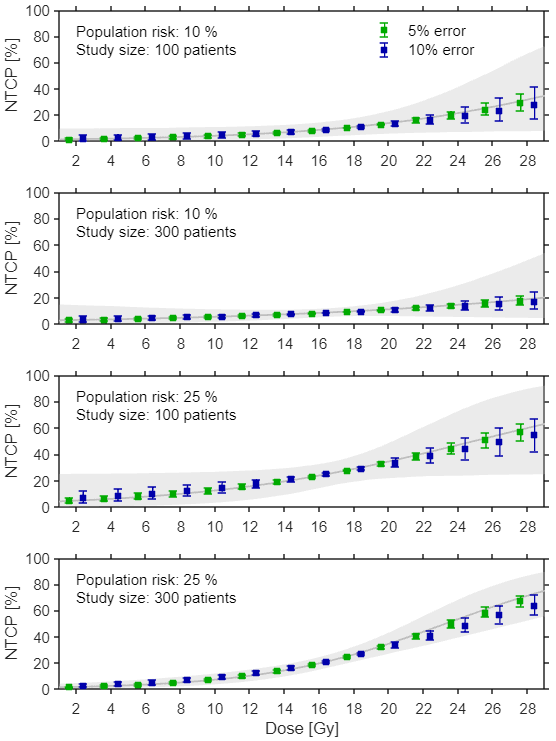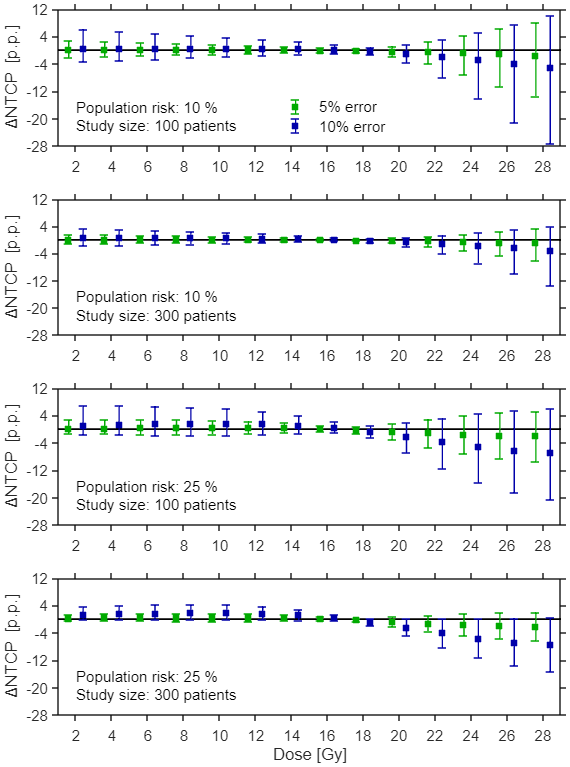Impact of dose errors on dose-response modelling
PO-1764
Abstract
Impact of dose errors on dose-response modelling
Authors: Louise Mövik1, Anna Bäck2,1, Niclas Pettersson2,1
1University of Gothenburg, Sahlgrenska Academy, Institute of Clinical Sciences, Department of Medical Radiation Sciences, Gothenburg, Sweden; 2Sahlgrenska University Hospital, Medical Physics and Biomedical Engineering, Department of Therapeutic Radiation Physics, Gothenburg, Sweden
Show Affiliations
Hide Affiliations
Purpose or Objective
NTCP models are essential in RT as the basis for population-based planning objectives in treatment planning. The models result from analyses of clinical data, such as logistic regressions to estimate the relationship between the dose to an OAR and the risk of an outcome. However, the dose used to create a model, usually retrieved from a delineated volume in a treatment planning system, is just an estimation of the delivered dose to the organ. This estimation includes errors caused by for example calculation and delineation errors. The purpose of this study was to simulate how errors in the dose values used in dose-response modelling affects the resulting NTCP model.
Material and Methods
We simulated the dose-response modelling procedure by creating reference populations from a defined distribution of dose values with an assumed dose-response relationship, and introducing dose errors repeatedly. Dose values within each reference population were randomly generated from a normal distribution, 16±4 Gy (mean±1 SD) truncated at ±3 SD. This corresponds to the distribution of mean lung doses when treating lung cancer with conventional RT at our hospital.
Four general scenarios were considered: population risks of either 10 or 25% in combination with study sizes of either 100 or 300 patients. Each patient within the reference populations was assigned an endpoint based on an NTCP model where the dose-response parameter γ50 was set to 1.0 and the D50 was calculated to match the population risk in each scenario. If a randomly generated number between 0 and 100% was less than or equal to the calculated NTCP, an endpoint of 1 was given, otherwise 0.
We randomly created 50 reference populations. For all reference populations, we estimated their reference NTCP models using logistic regression and the 95% CIs with bootstrapping.
For each reference population in each scenario, we repeatedly (1000 times) introduced random relative dose errors to the reference doses. The errors were randomly sampled from normal distributions (0±5% or 0±10%) truncated at ±3 SD. New NTCP models were estimated using the doses with introduced errors.
Results
The larger dose error resulted in larger systematic over- and underestimations of the NTCP for doses below and above 16 Gy, respectively, see Figure 1 and 2.

Figure 1. As an example, the reference NTCP model for one of the reference populations (grey line) and its bootstrapped 95% CIs (grey area). The boxes represent the median NTCP of the models generated with dose errors and the error bars represent the 95% CIs.

Figure 2. The differences in NTCP between the NTCP models generated with dose errors and their respective reference NTCP model. The boxes represent the median and the error bars the 95% CIs.
Conclusion
In the majority of the cases, 95% of the NTCPs from NTCP models generated with dose errors were within the 95% CI of the reference NTCP model. The larger dose error was associated with larger systematic underestimations of the NTCP for higher doses.